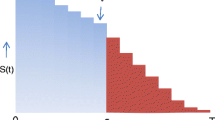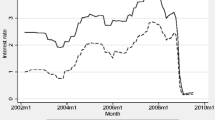Abstract
In surveys of 3,000 households, we have found that people attach less importance to saving lives in the future than to saving lives today, and less importance to saving older persons than to saving younger persons. For the median respondent, saving six people in 25 years is equivalent to saving one person today, while for a horizon of 100 years, 45 persons must be saved for every person saved today. The age of those saved also matters; however, respondents do not weight lives saved by number of life-years remaining: For the median respondent, saving one 20-year-old is equivalent to saving seven 60-year-olds.
Similar content being viewed by others
References
Ainslie, George. (1991). “Derivation of Rational' Economic Behavior from Hyperbolic Discount Curves,”The American Economic Review 81, 334–340.
Cylke, Steven et al. (1982). “An Estimate of the Personal Discount Rate: Evidence from Military Career Decisions.” Professional Paper #356, Center for Naval Analyses, Washington, D.C.
Hanemann, Michael, John Loomis, and Barbara Kanninen. (1991). “Statistical Efficiency of Double-Bounded Dichotomous Choice Contingent Valuation,”American Journal of Agricultural Economics 73, 1255–1263.
Harvey, Charles M. (1986). “Value Functions for Infinite-Period Planning,”Management Science 32, 1123–1139.
Hausman, Jerry A. (1979). “Individual Discount Rates and the Purchase and Utilization of Energy-Using Durables,”The Bell Journal of Economics 10, 33–54.
Horowitz, John K. (1991). “Discounting Money Payoffs: An Experimental Analysis.” In Stanley Kaish and Benjamin Gilad, (eds.),Handbook of Behavioral Economics. Greenwich, Conn.: JAI Press.
Keeler, Emmett B., and Shan Cretin. (1983). “Discounting of Life-Saving and Other Nonmonetary Effects,”Management Science 29, 300–306.
Kristrom, Bengt. (1990). “A Non-Parametric Approach to the Estimation of Welfare Measures in Discrete Response Valuation Studies,”Land Economics 66, 135–139.
Lawrance, Emily C. (1991). “Poverty and the Rate of Time Preference: Evidence from Panel Data,”Journal of Political Economy 99, 54–77.
Leigh, J. Paul. (1986). “Accounting for Tastes: Correlates of Risk and Time Preference,”Journal of Post-Keynesian Economics 9, 17–31.
Lowenstein, George, and Richard Thaler. (1989). “Intertemporal Choice,”Journal of Economic Perspectives 3, 181–193.
Thaler, Richard. (1981). “Some Empirical Evidence on Dynamic Inconsistency,”Economics Letters 8, 201–207.
Tversky, Amos, Shmuel Sattath, and Paul Slovic. (1988). “Contingent Weighting in Judgement and Choice,”Psychological Review 95, 371–384.
Viscusi, W. Kip, and Michael J. Moore (1989). “Rates of Time Preference and Valuations of the Duration of Life,”Journal of Public Economics 38, 297–317.
Winston, Gordon C., and Richard G. Woodbury. (1991). “Myopic Discounting: Empirical Evidence.” In Stanley Kaish and Benjamin Gilad (eds.),Handbook of Behavioral Economics. Greenwich, Conn.: JAI Press.
Author information
Authors and Affiliations
Rights and permissions
About this article
Cite this article
Cropper, M.L., Aydede, S.K. & Portney, P.R. Preferences for life saving programs: how the public discounts time and age. J Risk Uncertainty 8, 243–265 (1994). https://doi.org/10.1007/BF01064044
Issue Date:
DOI: https://doi.org/10.1007/BF01064044




